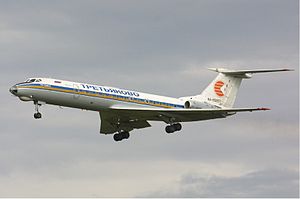| Tu-134 | |
|---|---|
 A Tretyakovo Air Transport Tu-134 at Domodedovo International Airport | |
| General information | |
| Type | Airliner |
| National origin | Soviet Union |
| Designer | Tupolev |
| Built by | Kharkiv State Aircraft Manufacturing Company |
| Status | In limited use |
| Primary users | Aeroflot (historical) |
| Number built | 854 (852 + 2 prototypes)[1] |
| History | |
| Manufactured | 1966–1989[1] |
| Introduction date | 9 September 1970 [2] |
| First flight | 29 July 1963 |
| Developed from | Tupolev Tu-124 |
The Tupolev Tu-134 (NATO reporting name: Crusty) is a twin-engined, narrow-body jet airliner built in the Soviet Union for short and medium-haul routes from 1966 to 1989. The original version featured a glazed-nose design and, like certain other Russian airliners (including its sister model the Tu-154), it can operate from unpaved airfields.
One of the most widely used aircraft in former Comecon countries, the number in active service is decreasing because of operational safety concerns and noise restrictions. The model has seen long-term service with some 42 countries, with some European airlines having scheduled as many as 12 daily takeoffs and landings per plane. In addition to regular passenger service, it has also been used in various air force, army and navy support roles; for pilot and navigator training; and for aviation research and test projects. In recent years, a number of Tu-134s have been converted for use as VIP transports and business jets. A total of 854 Tu-134s were built of all versions (including test bed examples) with Aeroflot as the largest user by 1995, the Tu-134 had carried 360 million passengers for that airline.
- ^ a b Ту-134. russianplanes.net (in Russian). Archived from the original on 4 September 2015. Retrieved 2 November 2015.
- ^ http://aeroflotarchives.com/tupolev-tu-134.html Archived 27 July 2020 at the Wayback Machine Cites first revenue flight, Accessed 15 April 2019